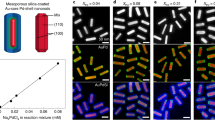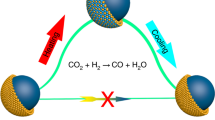Abstract
Core@shell structured bimetallic nanoparticles are currently of immense interest due to their unique electronic, optical and catalytic properties. However, their synthesis is non-trivial. We report a new supramolecular route for the synthesis of core@shell nanoparticles, based on an anion coordination protocol—the first to function by binding the shell metal to the surface of the pre-formed primary metal core before reduction. The resultant gold/palladium and platinum/palladium core@shell nanoparticles have been characterized by aberration-corrected scanning transmission electron microscopy (as well as other techniques), giving striking atomic-resolution images of the core@shell architecture, and the unique catalytic properties of the structured nanoparticles have been demonstrated in a remarkable improvement of the selective production of industrially valuable chloroaniline from chloronitrobenzene.
This is a preview of subscription content, access via your institution
Access options
Subscribe to this journal
Receive 12 print issues and online access
$259.00 per year
only $21.58 per issue
Buy this article
- Purchase on Springer Link
- Instant access to full article PDF
Prices may be subject to local taxes which are calculated during checkout



Similar content being viewed by others
References
Daniel, M.-C. & Astruc, D. Gold nanoparticles: assembly, supramolecular chemistry, quantum-size-related properties, and applications toward biology, catalysis, and nanotechnology. Chem. Rev. 104, 293–346 (2004).
Yao, T. et al. Insights into initial kinetic nucleation of gold nanocrystals. J. Am. Chem. Soc. 132, 7696–7701 (2010).
Templeton, A. C., Wuelfing, W. P. & Murray, R. W. Monolayer-protected cluster molecules. Acc. Chem. Res. 33, 27–36 (2000).
Coskun, A. et al. Molecular-mechanical switching at the nanoparticle–solvent interface: practice and theory. J. Am. Chem. Soc. 132, 4310–4320 (2010).
Zeng, Q. et al. Host–guest directed assembly of gold nanoparticle arrays. Langmuir 26, 1325–1333 (2009).
Wang, Z. & Ma, L. Gold nanoparticle probes. Coord. Chem. Rev. 253, 1607–1618 (2009).
Sessler, J. L., Gale, P. A. & Cho, W.-S. Anion Receptor Chemistry (Royal Society of Chemistry, 2006).
Pedro, M. & Jaïrton, D. Catalytic applications of metal nanoparticles in imidazolium ionic liquids. Chem. Eur. J. 13, 32–39 (2007).
Zhang, K. et al. Enhanced optical responses of Au@Pd core/shell nanobars. Langmuir 25, 1162–1168 (2009).
Sobal, N. S. et al. Synthesis and structure of colloidal bimetallic nanocrystals: the non-alloying system Ag/Co. Nano Lett. 2, 621–624 (2002).
Moskovits, M., Srnova-Sloufova, I. & Vlckova, B. Bimetallic Ag–Au nanoparticles: extracting meaningful optical constants from the surface-plasmon extinction spectrum. J. Chem. Phys. 116, 10435–10446 (2002).
Kobayashi, H., Yamauchi, M., Ikeda, R. & Kitagawa, H. Atomic-level Pd–Au alloying and controllable hydrogen-absorption properties in size-controlled nanoparticles synthesized by hydrogen reduction. Chem. Commun. 4806–4808 (2009).
Alayoglu, S. & Eichhorn, B. Rh@Pt bimetallic catalysts: synthesis, characterization, and catalysis of core@shell, alloy, and monometallic nanoparticles. J. Am. Chem. Soc. 130, 17479–17486 (2008).
Alayoglu, S., Nilekar, A. U., Mavrikakis, M. & Eichhorn, B. Ru–Pt core-–shell nanoparticles for preferential oxidation of carbon monoxide in hydrogen. Nature Mater. 7, 333–338 (2008).
Enache, D. I. et al. Solvent-free oxidation of primary alcohols to aldehydes using Au–Pd/ TiO2 catalysts. Science 311, 362–365 (2006).
Park, J. H. & Chung, Y. K. Cobalt–rhodium heterobimetallic nanoparticle-catalyzed reactions. Dalton Trans. 2369–2378 (2008).
Toshima, N., Harada, M., Yamazaki, Y. & Asakura, K. Catalytic activity and structural analysis of polymer-protected gold–palladium bimetallic clusters prepared by the simultaneous reduction of hydrogen tetrachloroaurate and palladium dichloride. J. Phys. Chem. 96, 9927–9933 (1992).
Edwards, J. K. & Hutchings, G. J. Palladium and gold–palladium catalysts for the direct synthesis of hydrogen peroxide. Angew. Chem. Int. Ed. 47, 9192–9198 (2008).
Schmid, G., West, H., Mehles, H. & Lehnert, A. Hydrosilation reactions catalyzed by supported bimetallic colloids. Inorg. Chem. 36, 891–895 (1997).
Zhang, J. et al. Platinum monolayer on non-noble metal@noble metal core@shell nanoparticle electrocatalysts for O2 reduction. J. Phys. Chem. B 109, 22701–22704 (2005).
Harada, M., Asakura, K. & Toshima, N. Catalytic activity and structural analysis of polymer-protected gold/palladium bimetallic clusters prepared by the successive reduction of hydrogen tetrachloroaurate(III) and palladium dichloride. J. Phys. Chem. 97, 5103–5114 (1993).
Yu, H., Gibbons, P. C., Kelton, K. F. & Buhro, W. E. Heterogeneous seeded growth: a potentially general synthesis of monodisperse metallic nanoparticles. J. Am. Chem. Soc. 123, 9198–9199 (2001).
Toshima, N. et al. Novel synthesis, structure and catalysis of inverted core/shell structured Pd/Pt bimetallic nanoclusters. Eur. Phys. J. D 16, 209–212 (2001).
Turkevich, J. & Kim, G. Palladium: preparation and catalytic properties of particles of uniform size. Science 169, 873–879 (1970).
Brown, K. R. & Natan, M. J. Hydroxylamine seeding of colloidal Au nanoparticles in solution and on surfaces. Langmuir 14, 726–728 (1998).
Lee, W.-R. et al. Redox-transmetalation process as a generalized synthetic strategy for core@shell magnetic nanoparticles. J. Am. Chem. Soc. 127, 16090–16097 (2005).
Xie, W. et al. Synthesis of gold nanopeanuts by citrate reduction of gold chloride on gold–silver core–shell nanoparticles. Chem. Commun. 5263–5265 (2009).
Mallik, K., Mandal, M., Pradhan, N. & Pal, T. Seed mediated formation of bimetallic nanoparticles by UV irradiation: a photochemical approach for the preparation of core@shell type structures. Nano Lett. 1, 319–322 (2001).
Lee, Y. W., Kim, M., Kim, Z. H. & Han, S. W. One-step synthesis of Au@Pd core@shell nanooctahedron. J. Am. Chem. Soc. 131, 17036–17037 (2009).
Mizukoshi, Y. et al. Characterization and catalytic activity of core@shell structured gold/palladium bimetallic nanoparticles synthesized by the sonochemical method. J. Phys. Chem. B 104, 6028–6032 (2000).
Yan, J.-M. et al. One-step seeding growth of magnetically recyclable Au@Co core@shell nanoparticles: highly efficient catalyst for hydrolytic dehydrogenation of ammonia borane. J. Am. Chem. Soc. 132, 5326–5327 (2010).
Mayrhofer, K. J. J. et al. Adsorbate-induced surface segregation for core–shell nanocatalysts. Angew. Chem. Int. Ed. 48, 3529–3531 (2009).
Astruc, D., Boisselier, E. & Ornelas, C. Dendrimers designed for functions: from physical, photophysical, and supramolecular properties to applications in sensing, catalysis, molecular electronics, photonics, and nanomedicine. Chem. Rev. 110, 1857–1959 (2010).
Labande, A., Ruiz, J. & Astruc, D. Supramolecular gold nanoparticles for the redox recognition of oxoanions: syntheses, titrations, stereoelectronic effects, and selectivity. J. Am. Chem. Soc. 124, 1782–1789 (2002).
Watanabe, S. et al. Enhanced optical sensing of anions with amide-functionalized gold nanoparticles. Chem. Commun. 2866–2867 (2002).
Brust, M. et al. Synthesis of thiol-derivatised gold nanoparticles in a two-phase liquid–liquid system. J. Chem. Soc. Chem. Commun. 801–802 (1994).
Wagner, C. D. et al. Empirical atomic sensitivity factors for quantitative analysis by electron spectroscopy for chemical analysis. Surf. Interface Anal. 3, 211–225 (1981).
Zeng, J., Yang, J., Lee, J. Y. & Zhou, W. Preparation of carbon-supported core@shell Au@Pt nanoparticles for methanol oxidation reaction: the promotional effect of the Au core. J. Phys. Chem. B 110, 24606–24611 (2006).
Liu, H., Mao, G. & Meng, S. Preparation and characterization of the polymer-protected palladium-gold colloidal bimetallic catalysts. J. Mol. Catal. 74, 275–284 (1992).
Weir, M. G., Knecht, M. R., Frenkel, A. I. & Crooks, R. M. Structural analysis of PdAu dendrimer-encapsulated bimetallic nanoparticles. Langmuir 26, 1137–1146 (2009).
Sanchez, S. I., Small, M. W., Zuo, J.-M. & Nuzzo, R. G. Structural characterization of Pt@Pd and Pd@Pt core@shell nanoclusters at atomic resolution. J. Am. Chem. Soc. 131, 8683–8689 (2009).
Lim, B. et al. Pd-Pt bimetallic nanodendrites with high activity for oxygen reduction. Science 324, 1302–1305 (2009).
Jiang, L., Gu, H., Xu, X. & Yan, X. Selective hydrogenation of o-chloronitrobenzene (o-CNB) over supported Pt and Pd catalysts obtained by laser vaporization deposition of bulk metals. J. Mol. Catal. A 310, 144–149 (2009).
Liu, H. et al. An excellent Pd-based nanocomposite catalyst for the selective hydrogenation of para-chloronitrobenzene. J. Mol. Catal. A 308, 79–86 (2009).
Cárdenas-Lizana, F. et al. Pd-promoted selective gas phase hydrogenation of p-chloronitrobenzene over alumina supported Au. J. Catal. 262, 235–243 (2009).
Kratky, V. et al. Effect of catalyst and substituents on the hydrogenation of chloronitrobenzenes. Appl. Catal. A 235, 225–231 (2002).
Meng, X. et al. Selective hydrogenation of chloronitrobenzene to chloroaniline in supercritical carbon dioxide over Ni/TiO2: significance of molecular interactions. J. Catal. 269, 131–139 (2010).
Liu, S.-J. et al. Controllable synthesis of VSB-5 microspheres and microrods: growth mechanism and selective hydrogenation catalysis. Chem. Eur. J. 14, 4074–4081 (2008).
Li, H. et al. Ni–B amorphous alloy deposited on an aminopropyl and methyl co-functionalized SBA-15 as a highly active catalyst for chloronitrobenzene hydrogenation. J. Mol. Catal. A 307, 105–114 (2009).
Acknowledgements
C.J.S. thanks Johnson Matthey and the Engineering and Physical Sciences Research Council for a CASE Studentship. ICP-MS analysis was conducted by G. Nnorom-Junior and J. McNaught, XPS by R.A.P. Smith, and TEM by G. Goodlet, at Johnson Matthey Technology Centre. We would also like to thank R.E. Palmer for allowing the use of the aberration corrected STEM facilities at the University of Birmingham, UK.
Author information
Authors and Affiliations
Contributions
P.D.B. and J.C. conceived the project. P.D.B., J.C. and C.J.S. designed the experiments. C.J.S. conducted the experiments. D.O. performed aberration corrected-high-angle annular dark field-scanning tunnelling electron microscopy. All authors contributed to analysis of the data. C.J.S., J.C. and P.D.B. wrote the paper.
Corresponding author
Ethics declarations
Competing interests
The authors declare no competing financial interests.
Supplementary information
Supplementary information
Supplementary information (PDF 6993 kb)
Supplementary information
Crystallographic data for TBA-AuCl4 (CIF 21 kb)
Supplementary information
Crystallographic data for TBA2-Pd2Cl6 (CIF 30 kb)
Rights and permissions
About this article
Cite this article
Serpell, C., Cookson, J., Ozkaya, D. et al. Core@shell bimetallic nanoparticle synthesis via anion coordination. Nature Chem 3, 478–483 (2011). https://doi.org/10.1038/nchem.1030
Received:
Accepted:
Published:
Issue Date:
DOI: https://doi.org/10.1038/nchem.1030
This article is cited by
-
Nano-engineering nanomedicines with customized functions for tumor treatment applications
Journal of Nanobiotechnology (2023)
-
Core atoms escape from the shell: reverse segregation of Pb–Al core–shell nanoclusters via nanoscale melting
Discover Nano (2023)
-
Engineering gold-platinum core-shell nanoparticles by self-limitation in solution
Communications Chemistry (2022)
-
Synthesis of magnesium and Mg@Ni core-shell nanoparticles by microemulsion for hydrogen storage applications
Journal of Materials Science: Materials in Electronics (2022)
-
Ag, Co3O4, Ag–Co3O4, and Ag/Co3O4 Nanoparticles Decorated Mesoporous Natural Phosphate: Effect of Metal Synergy and Preparation Method on the Catalytic Reduction Reaction
Journal of Inorganic and Organometallic Polymers and Materials (2022)



